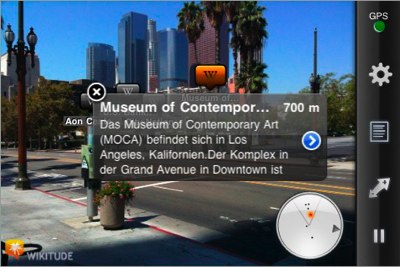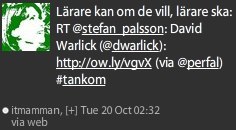 |
|
Education Leaders mesmerized by Will Richardson’s Keynote Address at the Long Island Technology Summit |
It was a good day yesterday and I do not believe that Will Richardson and I could have complimented each other’s messages any better if we’d planned it. The theme seemed to be “hyperconnected youngsters” — and what that means in the broader sense of education. Will does an amazing job of presenting a scenario, and then provoking educators to think about it from the perspective of students, their learning, and their future.
I did two breakout sessions called “Educating the Information Artisan.” I’d kicked around several ideas for this, but ended out generating some discussion around examples of infographics and data visualization — and potentials of getting students into that business. The discussion was great, but I was less than entirely satisfied with my work — partly because my voice was in shreds after the keynote (and a mild cold I’m getting over).
Now, ‘m wondering if I should have spent the time exploring applications similar to what Neil Stephenson is doing at the Calgary Science School. I had several conversations with Neil during and around some staff development I did in Calgary last week (or week before last?). His project started with a virtual visit to the Canadian Museum of Civilization in Ottawa, where he ran across an online display of old cigar boxes, called Canada in a Box. The exhibit, currated by Sheldon Posen, tells the story of Canada as expressed through the pictures printed on the covers of old cigar boxes.
A social studies teacher, Neil decided to make The Cigar Box Project an ongoing activity for his grade 7 students, asking them to produce cigar box printings that tell something of the history of Canada. Neil has written extensively about the project and it has been extensively written about — also earning the young teacher several prestigious accolades (he was too modest to clarify).
 |
|
Panels of student work in telling the history of Canada through Cigar Boxes. |
Being a 1:1 school, using mostly Apple Macs, they used Macromedia Fireworks to do their work, and extensive historic research as well as searches for public domain and creative commons licensed images to include. To the right are some example panels produced by these 7th graders — and as you can see, it is quite impressive work.I can barely imagine the amount of work that went into these panels. But I suppose that their investments of time and talent would fall into two categories. One is the intellectual effort and growing skills involved in locating and organizing their knowledge and media elements — and the decisions and associated criteria to tell their story. The second category would be the craftsmanship that the students developed and demonstrated in their work.
This video, which I may start using in one of my presentations, illustrates the work and skill that went into the construction of the panels.
Some students used Gawker to capture the remixing in progress. This video is 3.5 minutes long, but represents over 3 and a half hours of student work. Every second captures one minute of real time. Watch closely and see how many times this student goes off task. (( Stephenson, Neil. “Remixing in the Classroom: Student Propaganda Panels.” Thinking in Mind. 28 Apr 2009. Web. 29 Oct 2009. ))
The project seems to include all of the elements that I have been talking about lately in “Cracking the ‘Native’ Information Experience.” But there is one weakness to the project, as I see it. These 12 and 13 year-olds invested an enormous amount of research and craftsmanship (not to mention the hours) into producing these quite impressive displays. This work begs to be shared, and not just on a teacher’s blog.
I suggested this to Neil and he told me that he had made arrangements with the Ottawa museum and that an education consortium in Alberta was working on preparing the students’ work to be included in the online display. But the consortium project ran out of money and the preparations were not completed. But even this is not enough, in my opinion, to fully appreciate the work of these information artisans. It needs to be of practical value to be more than just classwork — no matter how engaged and personally invested the students were.
I just did some quick research and there are companies that will make custom-sized and printed boxes. What if some local company in Calgary donated the money to have 5,000 (arbitrary number) boxes produced, with the students panels printed on them, and sized to hold crayons for elementary students in the school. Each year, a new batch could be ordered and produced, based on that class’ work, and the next year, boxes are handed out to youngsters for their crayons, with the story that these boxes were created by 7th graders who used them to tell about Canada’s past.
Powered by ScribeFire.



















